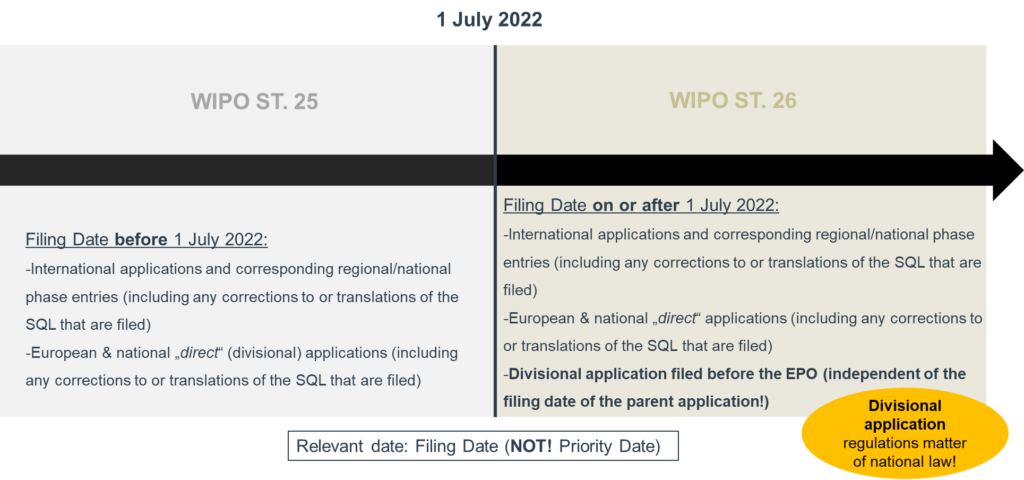On 1 July 2022 (the “Big Bang”-Date) a new sequence listing (SQL) standard will come into force. On that date, all Intellectual Property Offices will transit simultaneously at the international (PCT), national, and regional levels to SQL Standard ST. 26 as developed by the World Intellectual Property Organization (WIPO).
The new SQL format should facilitate the upload of sequence data from published and issued applications by Patent Offices to sequence databases such as UniProt, NCBI, DDBJ, and EMBL-EBI. According to the information from the WIPO, the current format (WIPO ST. 25) is not fully compliant with database requirements, so certain data is lost when entered into the above-mentioned public databases. Further, with ST. 26, several sequence types that are commonly used today (such as sequences with D-amino acids or branched sequences) can now be included in sequence listings and will consequently also be uploaded to publicly searchable databases.
A main difference between the new standard ST. 26 and the current standard ST. 25 is the file type. While ST. 25 is in txt-format, ST. 26 will have to be submitted in XML format. Moreover, while it was permitted to include sequences with less than 10 specifically defined nucleotides and less than 4 specifically defined amino acids in ST. 25, this is no longer allowed in ST. 26, which will impact the representation of short sequences such as primer sequences or sequences of antibody complementary determining regions, CDRs (while “specifically defined” means any nucleotide or amino acid that is not represented by “n” or “X”). Shorter sequences can, however, still be included in the specification as before. Further important differences are the number of priority applications, as well as applicants that can be included in the general information part of an SQL. While with the former standard ST. 25 all priority application information and all applicants may have been included, this is no longer the case for the new format. In ST. 26, only the earliest priority application and only the primary applicant will appear in the general information section of the SQL. Further interesting differences are that amino acids will now be presented in single letter-code (while being presented in three letter-code in ST. 25) and that “u” (for uracil) will no longer be used in nucleotide sequences. Instead, in ST. 26 format, “t” will represent both, uracil in RNA sequences and thymine in DNA sequences.
While several programs were available for the creation of ST. 25-conform SQLs, there is currently only one software tool, termed “WIPO Sequence”, available for the preparation of ST. 26-conform SQLs. With WIPO Sequence developed by the WIPO (current version: 2.1.0 released on 23 June 2022, available from the WIPO website), Applicants can prepare ready-to-file XML format SQLs. WIPO Sequence allows the import of ST. 25 SQLs and automatically converts, for instance, “u” residues in RNA sequences to “t”, as well as amino acid three letter-code into one letter-code. However, due to differences in the standard provisions, some mandatory fields in ST. 26 may need to be entered manually by the user. The software tool provides for an integrated validation function to allow the Applicant to check whether the created SQL complies with the ST. 26 provisions. As the software tool seems to be still under development, further release versions are expected to follow in the future.
The provisions of ST. 26 will apply to all applications (international, regional, and national ones) that are filed on or after 1 July 2022, while the decisive date is the filing date and not the priority date. In contrast, for applications (international, regional, and national ones) that are filed prior to 1 July 2022, ST. 25 will continue to apply. For instance, in case an international application is filed on 25 June 2022 (and thus with an SQL in the ST. 25 format), the regional/national phase must be entered also with ST.25-conform SQLs. Similarly, in case corrections (such as corrections under Rule 13ter.1 PCT) need to be filed for an international application that is filed on 25 June 2022 (and thus with an SQL in the ST. 25 format) or for corresponding national/regional stage entries of such an international application, the corrected SQL will also need to be filed in ST. 25-format. In contrast, whether divisional applications filed on or after 1 July 2022 need to comply with ST. 25 format or with ST. 26 format in case the parent application was filed before 1 July 2022 is, according to the WIPO, a matter of national law. The European Patent Office (EPO), for instance, has published in its Official Journal end of 2021 (OJ, 2021, A97) that also for divisional applications filed on or after 1 July 2022 -independent from the filing date of the parent application- an SQL must comply with the provisions of ST. 26 (see also the overview below).

Moreover, according to the PCT provisions that will enter into force on 1 July 2022 (PCT/AI/22 ADD.), an electronic file appearing to be a ST. 26-conform SQL shall not be taken into account when the international filing fee is calculated. However, if an electronic file is in any other format (such as ST. 25) or if an SQL is filed as PDF, the pages of such a file shall be taken into account when calculating the number of sheets for the filing fee. This approach is also applied by the EPO (see OJ, 2021, A97 and supplemental Notice from the EPO dated 27 May 2022 concerning the filing of SQLs in the international procedure before the EPO as Receiving Office published on 21 June 2022). As SQLs may be quite long, it seems also from a cost perspective point of view important to always proceed with the correct SQL format. Taken together, the new ST. 26 format will provide several advantages for Applicants, in particular regarding applications directed to sequences with characters that could not have been represented properly in the former ST. 25 format. Moreover, also the scientific community will benefit from ST. 26, as it will improve the upload of sequence data related to patents and patent applications into publicly searchable databases such as GenBank or UniProt. However, with the implementation of ST. 26, there will be also several aspects that need to be kept in mind by Applicants to ensure also from 1 July 2022 on a smooth proceeding with patent applications comprising sequences. We are in any event curiously looking forward to any further developments in connection to the new ST. 26 SQL standard coming into force on 1 July 2022.fux
